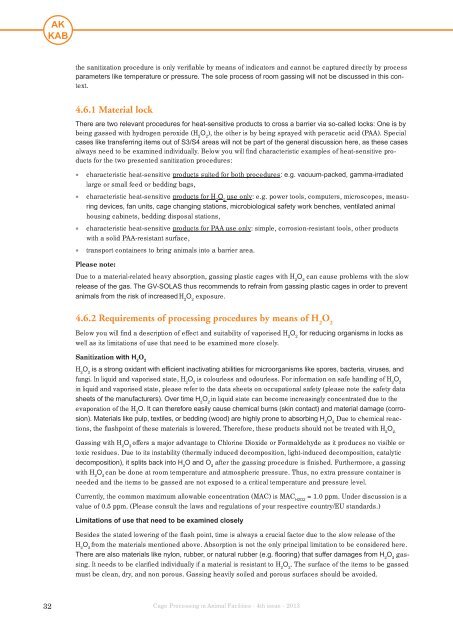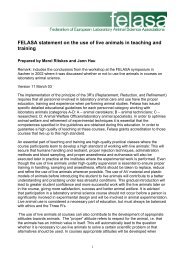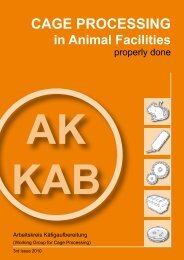CAGE PROCESSING in Animal Facilities - Felasa
CAGE PROCESSING in Animal Facilities - Felasa
CAGE PROCESSING in Animal Facilities - Felasa
- No tags were found...
You also want an ePaper? Increase the reach of your titles
YUMPU automatically turns print PDFs into web optimized ePapers that Google loves.
the sanitization procedure is only verifiable by means of <strong>in</strong>dicators and cannot be captured directly by processparameters like temperature or pressure. The sole process of room gass<strong>in</strong>g will not be discussed <strong>in</strong> this context.4.6.1 Material lockThere are two relevant procedures for heat-sensitive products to cross a barrier via so-called locks: One is bybe<strong>in</strong>g gassed with hydrogen peroxide (H 2O 2), the other is by be<strong>in</strong>g sprayed with peracetic acid (PAA). Specialcases like transferr<strong>in</strong>g items out of S3/S4 areas will not be part of the general discussion here, as these casesalways need to be exam<strong>in</strong>ed <strong>in</strong>dividually. Below you will f<strong>in</strong>d characteristic examples of heat-sensitive productsfor the two presented sanitization procedures:• characteristic heat-sensitive products suited for both procedures: e.g. vacuum-packed, gamma-irradiatedlarge or small feed or bedd<strong>in</strong>g bags,• characteristic heat-sensitive products for H 2O 2use only: e.g. power tools, computers, microscopes, measur<strong>in</strong>gdevices, fan units, cage chang<strong>in</strong>g stations, microbiological safety work benches, ventilated animalhous<strong>in</strong>g cab<strong>in</strong>ets, bedd<strong>in</strong>g disposal stations,• characteristic heat-sensitive products for PAA use only: simple, corrosion-resistant tools, other productswith a solid PAA-resistant surface,• transport conta<strong>in</strong>ers to br<strong>in</strong>g animals <strong>in</strong>to a barrier area.Please note:Due to a material-related heavy absorption, gass<strong>in</strong>g plastic cages with H 2O 2can cause problems with the slowrelease of the gas. The GV-SOLAS thus recommends to refra<strong>in</strong> from gass<strong>in</strong>g plastic cages <strong>in</strong> order to preventanimals from the risk of <strong>in</strong>creased H O exposure.2 24.6.2 Requirements of process<strong>in</strong>g procedures by means of H 2O 2Below you will f<strong>in</strong>d a description of effect and suitability of vaporised H 2O 2for reduc<strong>in</strong>g organisms <strong>in</strong> locks aswell as its limitations of use that need to be exam<strong>in</strong>ed more closely.Sanitization with H 2O 2H 2O 2is a strong oxidant with efficient <strong>in</strong>activat<strong>in</strong>g abilities for microorganisms like spores, bacteria, viruses, andfungi. In liquid and vaporised state, H 2O 2is colourless and odourless. For <strong>in</strong>formation on safe handl<strong>in</strong>g of H 2O 2<strong>in</strong> liquid and vaporised state, please refer to the data sheets on occupational safety (please note the safety datasheets of the manufacturers). Over time H 2O 2<strong>in</strong> liquid state can become <strong>in</strong>creas<strong>in</strong>gly concentrated due to theevaporation of the H 2O. It can therefore easily cause chemical burns (sk<strong>in</strong> contact) and material damage (corrosion).Materials like pulp, textiles, or bedd<strong>in</strong>g (wood) are highly prone to absorb<strong>in</strong>g H 2O 2.Due to chemical reactions,the flashpo<strong>in</strong>t of these materials is lowered. Therefore, these products should not be treated with H 2O 2.Gass<strong>in</strong>g with H 2O 2offers a major advantage to Chlor<strong>in</strong>e Dioxide or Formaldehyde as it produces no visible ortoxic residues. Due to its <strong>in</strong>stability (thermally <strong>in</strong>duced decomposition, light-<strong>in</strong>duced decomposition, catalyticdecomposition), it splits back <strong>in</strong>to H 2O and O 2after the gass<strong>in</strong>g procedure is f<strong>in</strong>ished. Furthermore, a gass<strong>in</strong>gwith H 2O 2can be done at room temperature and atmospheric pressure. Thus, no extra pressure conta<strong>in</strong>er isneeded and the items to be gassed are not exposed to a critical temperature and pressure level.Currently, the common maximum allowable concentration (MAC) is MAC H2O2= 1.0 ppm. Under discussion is avalue of 0.5 ppm. (Please consult the laws and regulations of your respective country/EU standards.)Limitations of use that need to be exam<strong>in</strong>ed closelyBesides the stated lower<strong>in</strong>g of the flash po<strong>in</strong>t, time is always a crucial factor due to the slow release of theH 2O 2from the materials mentioned above. Absorption is not the only pr<strong>in</strong>cipal limitation to be considered here.There are also materials like nylon, rubber, or natural rubber (e.g. floor<strong>in</strong>g) that suffer damages from H 2O 2gass<strong>in</strong>g.It needs to be clarified <strong>in</strong>dividually if a material is resistant to H 2O 2. The surface of the items to be gassedmust be clean, dry, and non porous. Gass<strong>in</strong>g heavily soiled and porous surfaces should be avoided.32Cage Process<strong>in</strong>g <strong>in</strong> <strong>Animal</strong> <strong>Facilities</strong> · 4th issue · 2013






